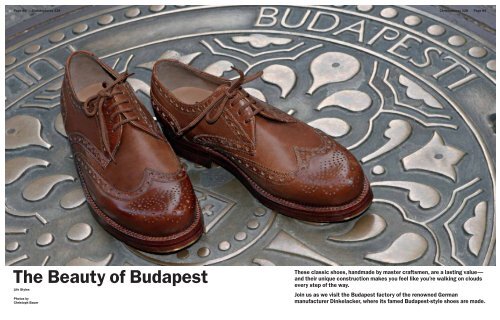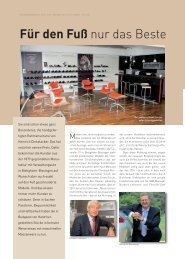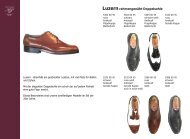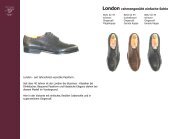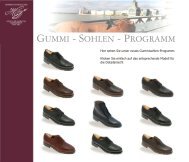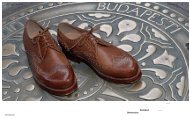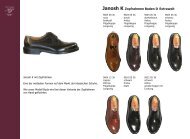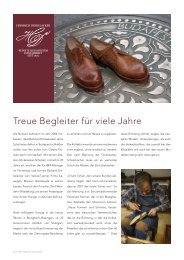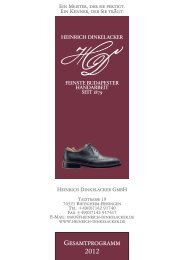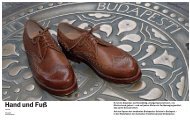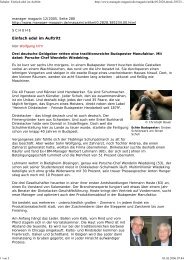The Beauty of Budapest - Heinrich Dinkelacker GmbH
The Beauty of Budapest - Heinrich Dinkelacker GmbH
The Beauty of Budapest - Heinrich Dinkelacker GmbH
Create successful ePaper yourself
Turn your PDF publications into a flip-book with our unique Google optimized e-Paper software.
Page 88<br />
Christophorus 328<br />
Christophorus 328<br />
Page 89<br />
<strong>The</strong> <strong>Beauty</strong> <strong>of</strong> <strong>Budapest</strong><br />
Life Styles<br />
Photos by<br />
Christoph Bauer<br />
<strong>The</strong>se classic shoes, handmade by master craftsmen, are a lasting value—<br />
and their unique construction makes you feel like you’re walking on clouds<br />
every step <strong>of</strong> the way.<br />
Join us as we visit the <strong>Budapest</strong> factory <strong>of</strong> the renowned German<br />
manufacturer <strong>Dinkelacker</strong>, where its famed <strong>Budapest</strong>-style shoes are made.
Page 90<br />
Christophorus 328<br />
Christophorus 328<br />
Page 91<br />
Made by hand:<br />
Each shoe is manufactured in the original sense <strong>of</strong> the word—made<br />
by hand—in a process consisting <strong>of</strong> about 300 individual steps<br />
es away—as he has every day from 6:00 a.m. to 2:00 p.m. for the<br />
past 51 years. In total, 62 stitches per shoe, 124 stitches per pair.<br />
<strong>The</strong> calluses on the 65-year-old’s hands testify eloquently to a life<br />
<strong>of</strong> hard work put into his craft. Szücs once calculated that he<br />
could circle the globe twice with the twine he himself has used in<br />
the past half a century. With the pride <strong>of</strong> a man who holds himself<br />
straight as a ramrod in spite <strong>of</strong> severe back problems, he says,<br />
“In all those years, nothing has changed. We still make the shoes<br />
the same way we did back then.” Though he’s not quite as fast as<br />
he used to be, his fingers are as nimble as ever and he can still hold<br />
his own with any <strong>of</strong> the other 26 trained craftsmen employed<br />
here. “I still manage to get six or seven pairs done per day.”<br />
All in all, the company employs a staff <strong>of</strong> 35 here in <strong>Budapest</strong>. <strong>The</strong><br />
jobs are sought after—they are paid at twice the average Hungarian<br />
wage. If one considers that craftsmanship like this can be regarded<br />
as an art, it is not surprising that it is rewarded handsomely—though,<br />
sadly, it isn’t awarded the social recognition it once<br />
was. And thus, though Szücs himself has stayed true to the old<br />
German proverb that says, “A shoemaker should stick with his<br />
last,” his son did not choose to follow in his footsteps. As Szücs<br />
says with a rueful grin, “He decided to become a vintner instead.”<br />
<strong>The</strong> contrast between <strong>Dinkelacker</strong>’s production facility in Hungary<br />
and the company’s gleaming new headquarters in Bietigheim-<br />
Bissingen near Stuttgart could hardly be more pronounced. It<br />
includes an elegant shop where customers can have a master<br />
shoemaker take measurements to ensure that the new <strong>Budapest</strong><br />
shoes will fit like a second skin.<br />
one—hasn’t found it difficult to interest the buyers <strong>of</strong> the upscale<br />
Hamburg and Berlin shops he caters to. As he says, “People<br />
don’t need much persuading when it comes to <strong>Budapest</strong><br />
shoes. <strong>The</strong>y represent luxury in the best sense <strong>of</strong> the word—exclusivity<br />
and pure pleasure.”<br />
If you take a look into the craftsmanship that is put into every<br />
shoe, it’s easy to understand why they cost what they do. <strong>The</strong><br />
leather is steamed to make it supple; then the pieces <strong>of</strong> leather for<br />
the upper are “clicked” (i.e., cut out) and stitched together. <strong>The</strong><br />
next steps are “closing”—stitching the pieces <strong>of</strong> the uppers and<br />
lining together—and “lasting,” or pulling the stitched-together<br />
upper and lining over the last and clamping it in place. It remains<br />
on the last for several days before it is removed—that ensures the<br />
shoe will retain its shape for a long time. <strong>The</strong>n the upper and lining<br />
are hand-sewn or “welted” to the flexible insole, with the<br />
thread knotted after every stitch. An additional cork insole is<br />
added for extra comfort and a “springy” step. Other steps include<br />
“making” (stitching the welt to the outsole and building<br />
the heels <strong>of</strong> the shoe) and “finishing” (polishing the uppers and<br />
soles, smoothing down the heel and sole edges, applying the edge<br />
dressing to the sole and heel edges, etc.).<br />
All in all, it takes about eight hours <strong>of</strong> work to make one pair <strong>of</strong><br />
shoes, or approximately 300 steps—each executed by hand,<br />
don’t forget—before the finished product undergoes its final inspection.<br />
If it passes muster, it is stamped with an inspection<br />
number and hand-signed by the master craftsman before it is<br />
ready to go to stores.<br />
<strong>Budapest</strong> shoes are probably the best known <strong>of</strong> all styles <strong>of</strong><br />
men’s dress shoes. What is the secret behind their enduring popularity?<br />
As a woman, I can’t try on a pair myself, so I decide to<br />
go to the source to find out what makes them so special.<br />
It turns out that the source isn’t easy to find. <strong>The</strong>re are no fancy<br />
signs pointing to the <strong>Dinkelacker</strong> production site on the outskirts<br />
<strong>of</strong> Hungary’s capital. Located in the building <strong>of</strong> a former<br />
women’s shoe factory, it is tucked away in a quiet, green suburb<br />
whose tidy little houses and lovingly tended fruit and vegetable<br />
gardens immediately give away its origins as a village. Dwarfed<br />
by a giant factory gate, the gatehouse at the entrance to the factory<br />
grounds looks uninviting. But looks can be deceiving: it is<br />
staffed with security guards around the clock—and for good<br />
reason. <strong>The</strong> leather stored here alone is worth a fortune: finest<br />
buffalo leather from Italy, lustrous aniline calf from France, and<br />
cordovan—made from horsehide, which stays smoother because<br />
<strong>of</strong> its high percentage <strong>of</strong> natural oils—from the famous<br />
Horween Leather Company in Chicago.<br />
However, the leather isn’t the only valuable thing here. <strong>The</strong> company’s<br />
most precious property is its lasts, which the master<br />
craftsmen at <strong>Dinkelacker</strong> are continually working to improve<br />
according to the newest research on the anatomy <strong>of</strong> the human<br />
foot. <strong>The</strong>y are the jealously guarded secret behind the unparalleled<br />
comfort <strong>of</strong> <strong>Dinkelacker</strong>’s <strong>Budapest</strong> shoes.<br />
Though <strong>Dinkelacker</strong> is a German company, its <strong>Budapest</strong> shoes<br />
are made in the city for which they are named, a city famous all<br />
over the world for its shoemaking craft. And indeed, what makes<br />
<strong>Dinkelacker</strong> shoes so unusual is that they are handcrafted from<br />
beginning to end, and thus one-<strong>of</strong>-a-kind works <strong>of</strong> art. That was<br />
the case when the company was founded in 1879, and the same<br />
holds true today.<br />
Visiting the factory is like stepping back in time. <strong>The</strong> sounds <strong>of</strong><br />
hammering and the pungent odors <strong>of</strong> glue and leather fill the air.<br />
<strong>The</strong> veranda on the third floor is taken up by shoes that have<br />
been placed in rows to dry. Piles <strong>of</strong> leather are weighed against<br />
iron weights on enormous scales. <strong>The</strong> few machines that are in<br />
evidence look like they would be more at home in a museum.<br />
<strong>The</strong> only thing that ruins the illusion is a solitary computer in<br />
one <strong>of</strong> the <strong>of</strong>fices.<br />
Indeed, the craftsmen here do most <strong>of</strong> their work with tools that<br />
their grandfathers might have used: hammer and anvil, nails,<br />
shoemaker’s awl and twine, brushes, and, last but not least, the<br />
trusty old Singer sewing machine. Hunched over a piece <strong>of</strong><br />
leather that her coworker has cut to shape with millimeter-precision,<br />
Erzsébet Albecker punches holes with meticulous care and<br />
stunningly nimble fingers. Perched on a stool, a half-finished<br />
shoe strapped to his thigh, master craftsman Gyula Szücs stitch-<br />
With a retail price <strong>of</strong> ¤400–600 a pair, they don’t come inexpensively.<br />
<strong>The</strong> steep price notwithstanding, authorized distributor<br />
Andreas Schläwicke—a passionate salesman if there ever was<br />
Masters <strong>of</strong> the art:<br />
In the <strong>Dinkelacker</strong> manufactory in <strong>Budapest</strong>,<br />
craftsmanship is elevated to an art<br />
Currently, <strong>Dinkelacker</strong> produces about 8,000 pairs <strong>of</strong> shoes a<br />
year. <strong>The</strong> distinguished company can look back on a 130-year<br />
tradition and was until recently run by the family <strong>of</strong> founder<br />
<strong>Heinrich</strong> <strong>Dinkelacker</strong>. Recently it opened a new chapter in its<br />
history when <strong>Heinrich</strong>’s grandson Burkhardt <strong>Dinkelacker</strong> decided<br />
to place his grandfather’s lovingly maintained legacy into the<br />
capable hands <strong>of</strong> Norbert Lehmann.<br />
He couldn’t have made a better choice, because Lehmann believes<br />
in traditional craftsmanship as passionately as <strong>Dinkelacker</strong> A
Page 92<br />
Christophorus 328<br />
Going the Distance<br />
A Guide to Men’s Shoe Styles<br />
As a rule <strong>of</strong> thumb, wear lace-up shoes for your most formal occasions.<br />
Open-throat or wide-set laces are less dressy than shoes with closedthroat<br />
or close-set laces. Cap-toed shoes are considered dressier than<br />
wingtip shoes.<br />
BUDAPEST<br />
Originating in Hungary, the classic among men’s shoes is a full brogue<br />
with sporty Derby-style open-throat lacing that lends it a refined yet casual<br />
look. “<strong>Budapest</strong>ers” are double-stitched and fashioned on special<br />
round-toe lasts that give them their characteristic form with high walls<br />
upturned at the toe. <strong>The</strong>y go equally well with suits and casual clothing.<br />
himself did. Lehmann bought his first pair <strong>of</strong> <strong>Budapest</strong> shoes 35<br />
years ago. <strong>The</strong> native <strong>of</strong> Bietigheim had just graduated with a degree<br />
in business management and was set to apply for his first<br />
“real” job, an executive-level position at IBM. Because his closet<br />
contained neither the requisite dark blue suit nor dress shoes,<br />
he went shopping. He was hooked. “I haven’t worn any other<br />
kind <strong>of</strong> dress shoes since.” And indeed, his “<strong>Budapest</strong>ers” seem to<br />
have worked like a charm—at least as far as his career is concerned.<br />
Lehmann held numerous high-level positions on the executive and<br />
supervisory boards <strong>of</strong> various companies before joining <strong>Dinkelacker</strong><br />
as managing partner.<br />
<strong>The</strong> position represented a perfect opportunity for a firm believer<br />
in the <strong>Dinkelacker</strong> product, though Lehmann does admit to<br />
being “shocked” when he first saw the rustic factory. “But I was<br />
soon captivated by the charm <strong>of</strong> the traditional methods and the<br />
passion put into every shoe.” Shortly after he came on board, he<br />
recruited the help <strong>of</strong> an experienced expert: Hermann Hoste, a<br />
former member <strong>of</strong> the board at Salamander, one <strong>of</strong> Europe’s<br />
leading shoe companies. <strong>The</strong>y are both confident that the current<br />
sales volume <strong>of</strong> ¤1.6 million per year can be increased. According<br />
to Hoste, “<strong>Dinkelacker</strong> shoes are an exclusive niche<br />
product, and with a good marketing strategy stressing the quality<br />
<strong>of</strong> our handcrafted shoes and fostering personal identification<br />
with our brand, I have no doubt we can tap into a larger segment<br />
<strong>of</strong> the national and international markets.”<br />
By the way, human beings walk an average <strong>of</strong> about 100,000<br />
miles during their lifetime. That’s a lot <strong>of</strong> miles. But when it comes<br />
to <strong>Budapest</strong> shoes, the same principle that applies to a Porsche<br />
applies here: the key to getting maximum mileage and performance<br />
is maintenance.<br />
<strong>The</strong> good news is—with good care and frequent tune-ups,<br />
they’ll last a lifetime.<br />
B<br />
This article is one <strong>of</strong> the last ones written by our esteemed colleague,<br />
the late Jutta Deiss, though a few facts were brought up to date.<br />
BOOT<br />
Boots come in a wide range <strong>of</strong> cuts, but the shaft always extends at<br />
least to the ankle. Boots are now considered appropriate for work during<br />
cold weather in all but the most conservative <strong>of</strong>fices.<br />
DERBY<br />
<strong>The</strong> Derby is characterized by its wide-set lacing; the various styles have<br />
between two and five holes. <strong>The</strong> classic Derby has a smooth vamp, but<br />
it is also produced in half-brogue styles, with a straight toe cap featuring<br />
decorative perforations, and as a full brogue with a wing tip. <strong>The</strong>y<br />
usually have a more casual, sporty look than the Oxford.<br />
FULL BROGUE<br />
This sturdy shoe features a robust sole and sides and is characterized<br />
by the elegant decorative perforated hole pattern on the toe cap. Full<br />
brogues are the perfect companions for practically any occasion.<br />
SEMI-BROGUE<br />
Though closely related to the Full Brogue, the design <strong>of</strong> the Semi-Brogue<br />
is finer and more filigree, and the pattern <strong>of</strong> holes is more restrained.<br />
This less sporty men’s shoe model is probably not for every man, and<br />
its elegant look is more suited to events <strong>of</strong> an <strong>of</strong>ficial or formal nature.<br />
LOAFER<br />
Typically flat, slip-on shoes with no laces, loafers come in many styles,<br />
both elegant and casual. Most loafers have a strap across the vamp incorporating<br />
decorative elements such as buckles, tassels, or, in the<br />
case <strong>of</strong> the classic “penny loafer,” a cutout. A shoehorn is a must when<br />
putting them on, or else they can easily lose their shape. Loafers are<br />
considered more appropriate for leisure pursuits than for business wear.<br />
LONGWING<br />
A striking, more sportive variation <strong>of</strong> the classic wingtip, in which the<br />
wings extend all the way back to the heel. Especially popular with<br />
younger buyers.<br />
MONK<br />
An extravagant cross between a loafer and a Derby, Monks have a buckle<br />
on the side rather than laces.<br />
OXFORD<br />
<strong>The</strong> “father” <strong>of</strong> all men’s business shoes. <strong>The</strong> restrained design makes<br />
for a very elegant effect. Usually made <strong>of</strong> high-quality, smooth black<br />
leather, Oxfords are easily recognized by their close-set lacing.
Page 94<br />
Christophorus 328<br />
Stepping<br />
Out<br />
Quality has its price, and that’s as true at the<br />
<strong>Dinkelacker</strong> store as anywhere else. But customers<br />
can rest assured they’ll be getting excellent<br />
value for their money at Talstrasse 19<br />
—conveniently located near Bietigheim’s<br />
medieval city center and just a few minutes’<br />
drive away from Porsche’s hometown <strong>of</strong><br />
Stuttgart-Zuffenhausen.<br />
<strong>The</strong> pleasurable anticipation <strong>of</strong> getting a<br />
handcrafted shoe quickens the pace <strong>of</strong> the<br />
customers who come here from all over the<br />
world. <strong>Dinkelacker</strong> uses twelve different<br />
lasts to make a total <strong>of</strong> 60 different models.<br />
In the shop, customers are fitted for their<br />
personal pair by master craftsman Christoph<br />
Renner. This constant contact keeps him in<br />
close touch with the Zeitgeist, and in the<br />
course <strong>of</strong> his private “market research” he<br />
has discerned a new trend. “People have become<br />
more quality-conscious, and now the<br />
younger generation has started to discover<br />
us.” And why not? After all, the desire to<br />
buy a pair <strong>of</strong> shoes that will last a lifetime is<br />
not restricted to any one age group. “If you<br />
pay for custom-made shoes, you have the<br />
right to expect something special.” And<br />
that’s what you get—every step <strong>of</strong> the way. B<br />
<strong>Heinrich</strong> <strong>Dinkelacker</strong> <strong>GmbH</strong><br />
Talstrasse 19<br />
74321 Bietigheim-Bissingen, Germany<br />
Tel.: +49-7142-9174-0<br />
Fax: +49-7142-917417<br />
www.heinrich-dinkelacker.de<br />
Measure <strong>of</strong> success:<br />
Master shoemaker Christoph Renner


